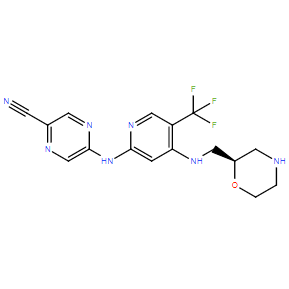| Cas No.: | 1489389-18-5 |
| Chemical Name: | 2-Pyrazinecarbonitrile, 5-[[4-[[(2R)-2-morpholinylmethyl]amino]-5-(trifluoromethyl)-2-pyridinyl]amino]- |
| Synonyms: | SRA-737;SRA737;SRA 737;CCT245737;CCT 245737 |
| SMILES: | FC(F)(F)C(C=NC(NC1=CN=C(C#N)C=N1)=C2)=C2NC[C@H]3CNCCO3 |
| Formula: | C16H16F3N7O |
| M.Wt: | 379.3398 |
| Purity: | >98% |
| Sotrage: | 2 years -20°C Powder, 2 weeks4°C in DMSO,6 months-80°C in DMSO |
| Description: | SRA737(CCT245737) is a orally active and seletive Chk1 inhibitor, with an IC50 of 1.3 nM。 |
| Target: | Chk1:1.3 nM (IC50) Chk2:2440 nM (IC50) ERK8:130 nM (IC50) PKD1:298 nM (IC50) RSK2:361 nM (IC50) RSK1:362 nM (IC50) FLT3:582 nM (IC50) MARK3:698 nM (IC50) NUAK1:711 nM (IC50) CLK2:1370 nM (IC50) BRSK1:1660 nM (IC50) AMPK:2970 nM (IC50) PHK:3470 nM (IC50) CDK2/CyclA:3850 nM (IC50) CDK1/CyclB:9030 nM (IC50) |
| In Vivo: | CCT245737 (150 mg/kg p.o.) inhibits tumor growth in combination with gemcitabine (100 mg/kg iv) in HT29 colon cancer xenografts. CCT245737 (300 mg/kg, p.o.) also inhibits the gemcitabine (60 mg/kg iv) induced pSer296 CHK1 autophosphorylation at 24 h in SW620 human colon cancer xenografts[1]. CCT245737 (150 mg/kg, p.o) alone significantly inhibits tumor growth in an Eμ-Myc mouse model of human B-cell lymphocytic leukemia[2]. |
| In Vitro: | CCT245737 (10 µM) shows >80% inhibition of a panel of 124 kinases, including ERK8, PKD1, RSK2 and RSK1 with IC50s of 130, 298, 361 and 362 nM[1]. CCT245737 abrogates an etoposide-induced G2 checkpoint in HT29, SW620, MiaPaCa-2, and Calu6 cell lines, with IC50s ranging from 30 to 220 nM[2]. |
| Kinase Assay: | Commercial in vitro 33P radiometric kinase assays are carried out against 124 human kinases using 10 μM CCT245737 at ATP concentrations corresponding to the kinase Km, ATP. Other kinase IC50 determinations for CHK2 and FLT3 are performed using a commercial assay or in-house with recombinant human CHK1 on a LabChip® EZ Reader II or CDK1 in a DELFIA assay[2]. |
| Cell Assay: | Cytotoxicity is determined as the drug concentration that gives 50% inhibition of tumor cell proliferation (GI50) using a 96 h Sulforhodamine B (SRB) assay. Inhibition of intracellular CHK1 activity is measured using a cell based ELISA for the abrogation of an etoposide induced G2 checkpoint (mitosis induction assay, MIA). The IC50 for G2 checkpoint abrogation (MIA) is determined in the presence of nocodazole using UCN01 as a positive control. The activity index (AI) is used as a measure of the compounds ability to induce mitosis relative to its toxicity (i.e., ratio of MIA IC50: 96 h SRB GI50). Routine potentiation studies are carried out using a fixed concentration (GI50) of either gemcitabine or SN38 in combination with a range of CCT245737 concentrations to determine the combination GI50 of CCT245737. The ability of CCT245737 to enhance gemcitabine or SN38 cell killing is expressed as a potentiation index (PI) equal to the ratio of the GI50 for CCT245737 alone versus the combination GI50 for CCT245737. PI values > 1 indicate potentiation of the genotoxic activity. In addition, a series of experiments is carried out using fixed, non- or minimally toxic concentrations of CCT245737 (≤GI20) with a range of different concentrations of gemcitabine or SN38 to determine the extent to which CCT245737 enhances drug cytotoxicity compared with the genotoxic agent alone, i.e. conventional PI (ratio GI50 genotoxic alone: GI50 genotoxic combined with non-toxic CCT245737 concentration, Con PI)[2]. |
| Animal Administration: | Human HT29 colorectal carcinoma cells are injected s.c into the flanks of female NCr athymic mice 6-8 weeks of age. Dosing commenced 5 days after transplantation when tumors reach a mean diameter of 5.5 mm. Gemcitabine (100 mg/kg i.v.) is dosed in saline on days 0, 7 and 14 and compounds 4 (CCT245737) and 41 (150 mg/kg p.o.) in 10% DMSO 20% PEG 400, 5% Tween 80, 65% water, 24 and 48 h after each dose of gemcitabine. Tumors are measured and body weights recorded three times weekly. Animals are culled on an individual basis when tumors reach a predetermined humane endpoint (mean diameter <15 mm)[1]. |
| References: | [1]. Osborne JD, et al. Multiparameter Lead Optimization to Give an Oral Checkpoint Kinase 1 (CHK1) Inhibitor Clinical Candidate: (R)-5-((4-((Morpholin-2-ylmethyl)amino)-5-(trifluoromethyl)pyridin-2-yl)amino)pyrazine-2-carbonitrile (CCT245737). J Med Chem. 2016 Jun 9;59(11):5221-37. [2]. Walton MI, et al. The clinical development candidate CCT245737 is an orally active CHK1 inhibitor with preclinical activity in RAS mutant NSCLC and Eμ-MYC driven B-cell lymphoma. |

 To enhance service speed and avoid tariff delays, we've opened a US warehouse. All US orders ship directly from our US facility.
To enhance service speed and avoid tariff delays, we've opened a US warehouse. All US orders ship directly from our US facility.




















